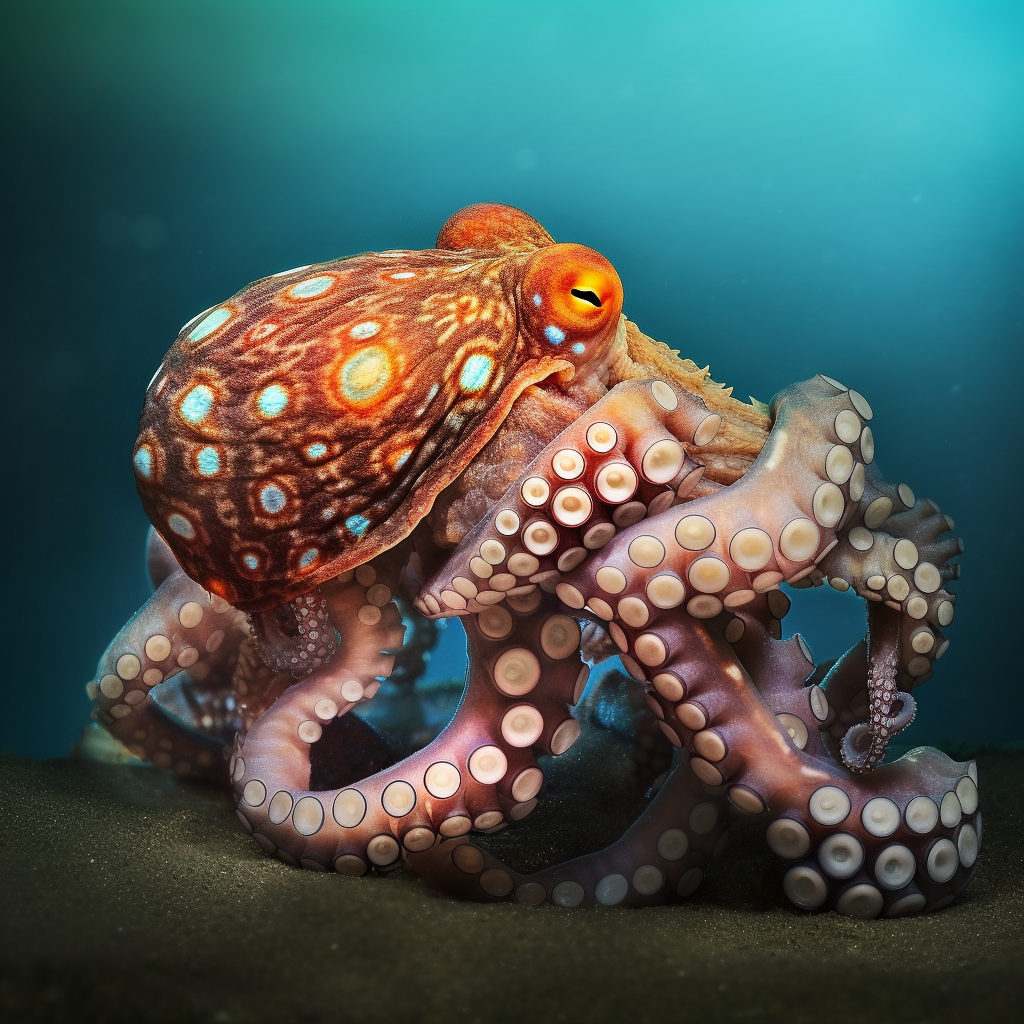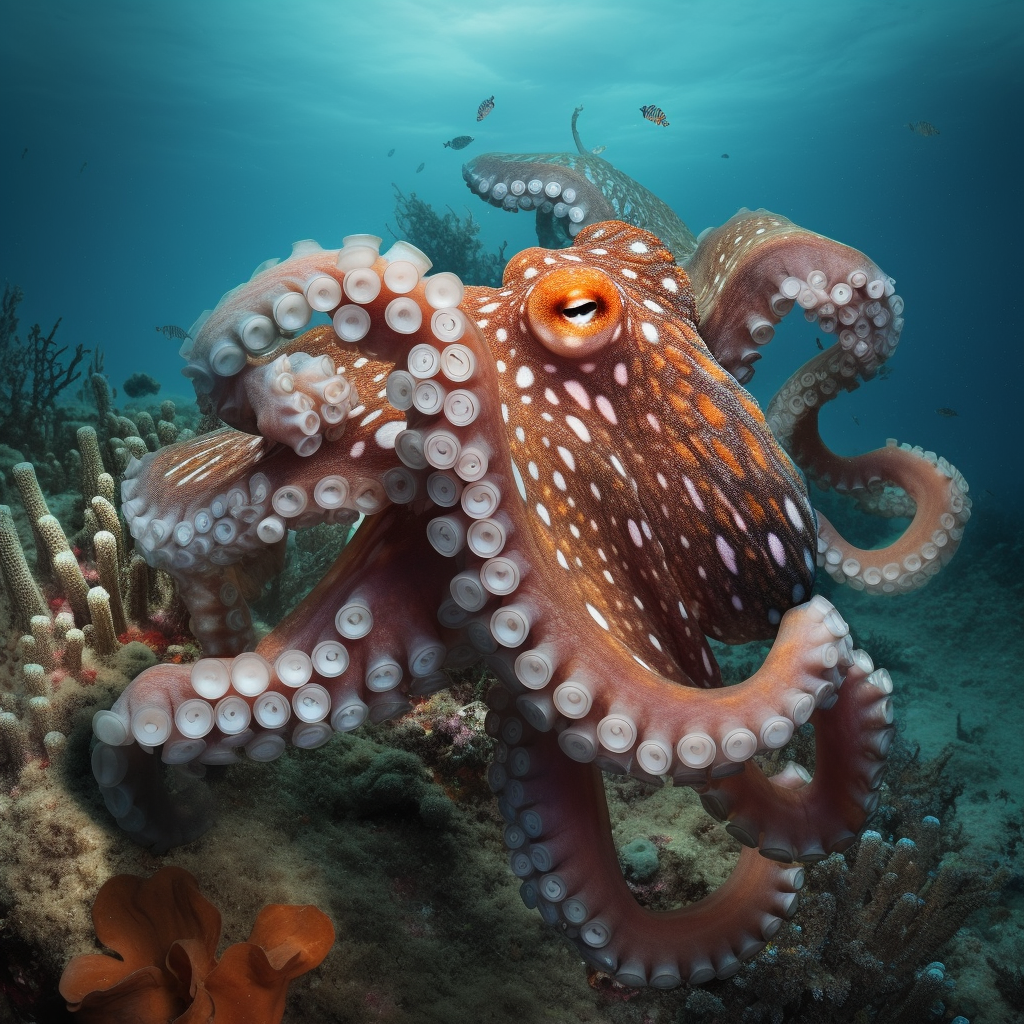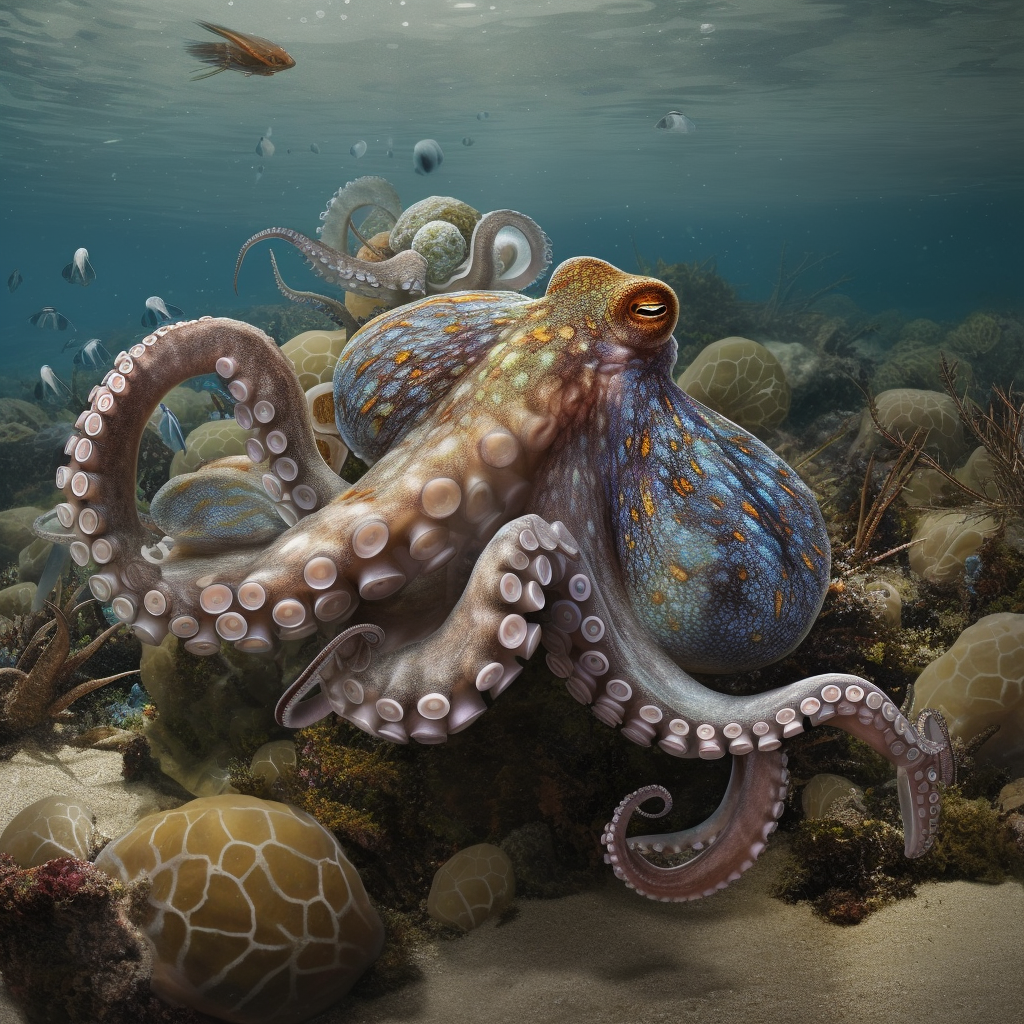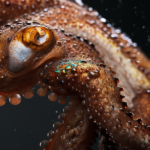Octopus reproduction is a fascinating and complex process that differs significantly from that of other animals. These intelligent creatures have evolved unique strategies to ensure the survival of their species. From their remarkable ability to change color and shape to their intricate courtship rituals, octopuses employ a variety of techniques to attract mates and reproduce successfully. In this article, we will explore the intricacies of octopus reproduction, including their reproductive organs, mating behaviors, and the remarkable journey of their offspring from birth to adulthood. So, let’s dive into the mysterious world of octopus reproduction and uncover the secrets of these incredible creatures.
Key Takeaways
- Octopuses have a unique reproductive process that involves both sexual and asexual reproduction.
- Female octopuses lay large numbers of eggs, which they guard and care for until they hatch.
- Male octopuses have a specialized arm called a hectocotylus, which they use to transfer sperm to the female during mating.
- Some species of octopuses reproduce only once in their lifetime and die shortly after, while others can reproduce multiple times.
- Octopuses have a short lifespan, and their reproductive strategies are influenced by their limited time for reproduction.
The Fascinating World of Octopus Reproduction

Octopuses are truly remarkable creatures, and their reproductive process is no exception. In this section, we will delve into the intriguing world of octopus reproduction, exploring the various stages and behaviors that contribute to the continuation of their species.
Mating and Fertilization
Octopus mating is a complex and often perilous affair. Male octopuses have a specialized arm called a hectocotylus, which they use to transfer sperm into the female’s body. This arm is specifically modified for reproduction, and its tip is packed with sperm packets known as spermatophores.
When a male octopus finds a suitable mate, he extends his hectocotylus towards the female, gently placing the spermatophores into her oviduct. The female then stores the sperm within her body until she is ready to fertilize her eggs.
Egg Laying and Brooding
Once fertilization occurs, the female octopus embarks on a remarkable journey of egg-laying and brooding. Depending on the species, the female may lay hundreds or even thousands of eggs. She carefully attaches these eggs to a suitable surface, such as rocks or coral, using a sticky substance secreted by her body.
The female octopus then assumes the role of a dedicated parent, tirelessly guarding and caring for her precious eggs. She diligently fans them with her arms to ensure a constant flow of oxygen and gently cleanses them to prevent the growth of harmful bacteria. This process requires immense dedication and energy, as the female must remain vigilant to protect her eggs from predators.
Embryonic Development and Hatching
As time passes, the eggs undergo a fascinating process of embryonic development. Within the protective confines of their egg capsules, the tiny octopus embryos begin to grow and develop. They absorb nutrients from the yolk sacs attached to their bodies, gradually transforming into fully formed hatchlings.
The duration of the embryonic development period varies among octopus species, ranging from several weeks to several months. During this time, the female octopus remains steadfast in her commitment to nurturing her offspring, rarely leaving their side.
Finally, the moment arrives when the hatchlings are ready to emerge from their egg capsules. They use a specialized tooth-like structure called a radula to break free, and with their newfound freedom, they embark on their own journey in the vast ocean.
Parental Care and Senescence
While most octopuses do not provide any parental care beyond the brooding stage, there are a few exceptions. Some species, such as the larger Pacific striped octopus, exhibit extended parental care. In these cases, the female octopus continues to protect and care for her hatchlings even after they have hatched.
As with all living creatures, octopuses eventually reach the end of their lifespan. After reproducing, they enter a stage known as senescence, where their bodies begin to deteriorate. This period is marked by a decline in overall health and reproductive capabilities. Eventually, the octopus will succumb to old age and pass away, leaving behind a legacy of new life.
Conclusion
The world of octopus reproduction is a captivating one, filled with intricate behaviors and remarkable adaptations. From the delicate process of mating and fertilization to the dedicated care provided by the female during the brooding stage, octopuses demonstrate a remarkable ability to ensure the survival of their species. As we continue to explore the depths of the ocean, we uncover more and more fascinating insights into the complex lives of these incredible creatures.
The Mating Process: A Deep Dive
A. How Male Octopuses Mate
The mating process of male octopuses is a fascinating and intricate affair. These intelligent creatures have developed unique strategies to ensure successful reproduction. Let’s take a closer look at how male octopuses mate.
-
Finding a Mate: Male octopuses are driven by their instincts to find a suitable female partner. They use their keen senses to locate a potential mate, relying on their excellent eyesight and sense of smell. Once they detect the presence of a female, they embark on a mission to win her over.
-
Mating Rituals: Male octopuses engage in elaborate mating rituals to attract females. These rituals often involve vibrant displays of color, intricate movements, and even changes in body texture. By showcasing their strength and agility, male octopuses aim to impress the females and demonstrate their fitness as potential mates.
-
The Art of Seduction: Male octopuses have a unique reproductive organ called a hectocotylus, which is a specialized arm used for transferring sperm to the female. During mating, the male carefully inserts his hectocotylus into the female’s mantle cavity, ensuring the successful delivery of his sperm.
-
Sperm Storage: Interestingly, female octopuses have the ability to store sperm for extended periods. This allows them to fertilize their eggs at a later time, ensuring the survival of their offspring. The female’s body is equipped to keep the sperm alive and viable until the conditions are optimal for fertilization.
B. The Female Octopus: From Mating to Motherhood
The female octopus plays a crucial role in the reproductive process, transitioning from mating to motherhood with remarkable precision. Let’s explore the journey of the female octopus from mating to motherhood.
-
Egg Laying: After mating, the female octopus begins the process of egg-laying. She carefully selects a suitable location to lay her eggs, often choosing a sheltered spot where they will be safe from predators. The female octopus uses her arms to create a protective environment for her eggs, guarding them diligently.
-
Brooding: Once the eggs are laid, the female octopus enters a period of intense brooding. She remains devoted to her eggs, tirelessly tending to them and ensuring their survival. The female octopus uses her arms to gently clean and aerate the eggs, providing them with the necessary oxygen for development.
-
Gestation Period: The gestation period for octopus eggs can vary depending on the species, ranging from a few weeks to several months. During this time, the female octopus diligently guards her eggs, fending off potential threats and predators. She sacrifices her own well-being to protect her offspring, often forgoing food and becoming weak as a result.
-
Hatching: Once the eggs have developed and are ready to hatch, the female octopus carefully tends to them, ensuring they have the best chance of survival. When the time comes, the hatchlings emerge from their eggs and enter the world as miniature versions of their parents. The female octopus takes great care in guiding her hatchlings, teaching them essential survival skills.
In conclusion, the mating process of octopuses is a complex and fascinating journey. Male octopuses employ various strategies to attract females, while females exhibit remarkable dedication and sacrifice in ensuring the survival of their offspring. Understanding the intricacies of octopus reproduction provides us with a deeper appreciation for these incredible creatures and their ability to adapt and thrive in their marine habitats.
Understanding the Octopus Reproduction Cycle
A. Octopus Reproduction Season
Octopuses have a fascinating reproductive cycle that is influenced by various factors, including environmental conditions and the availability of food. While different species of octopuses may have slight variations in their reproductive seasons, there are some general patterns that can be observed.
Most octopuses have a specific time of the year when they actively engage in reproduction. This period is often referred to as the “reproduction season.” During this time, male and female octopuses undergo significant physiological changes to prepare for mating and the subsequent development of eggs.
The exact timing of the reproduction season can vary depending on the species and the geographical location. Some octopuses reproduce during the spring or summer months, while others may reproduce during the colder months of the year. This timing is often influenced by factors such as water temperature, food availability, and the presence of potential mates.
B. Octopus Reproduction Lifespan
The lifespan of an octopus is an important factor in its reproductive cycle. Unlike many other animals, octopuses have a relatively short lifespan, with most species living for only a few years. This limited lifespan means that octopuses have a compressed reproductive timeline compared to other organisms.
On average, octopuses reach sexual maturity between the ages of one and two years. Once they reach this stage, they are able to reproduce and produce offspring. However, the exact lifespan and reproductive lifespan can vary depending on the species.
During their reproductive lifespan, female octopuses have a limited number of opportunities to reproduce. Unlike humans and many other animals, female octopuses do not go through a monthly reproductive cycle. Instead, they have a single reproductive event before they die.
Male octopuses, on the other hand, have a slightly longer reproductive lifespan. They are able to mate multiple times throughout their lives, increasing their chances of passing on their genes to future generations.
Overall, the reproductive lifespan of an octopus is relatively short, and they must make the most of their limited time to ensure the survival of their species. This compressed timeline adds an additional layer of complexity to the already fascinating world of octopus reproduction.
In the next section, we will explore the intricate process of octopus mating and the unique strategies they employ to ensure successful reproduction.
The Unique Reproduction Methods of Different Octopus Species

A. How Giant Octopus Reproduce
Giant octopuses are fascinating creatures known for their impressive size and intelligence. When it comes to reproduction, these majestic creatures have a unique and intriguing process.
-
Mating Rituals: Giant octopuses have elaborate mating rituals that involve both males and females. The male octopus will approach the female, displaying vibrant colors and intricate patterns on its body to attract her attention. This courtship display is a crucial part of the reproductive process.
-
Sperm Transfer: Once the female is receptive, the male transfers sperm to her using a specialized arm called a hectocotylus. This arm is longer and thinner than the others and is specifically designed for this purpose. The male carefully inserts the hectocotylus into the female’s mantle cavity, where the sperm is released.
-
Egg-Laying: After mating, the female giant octopus will find a suitable location to lay her eggs. She carefully attaches them to a hard surface, such as rocks or coral, using a sticky substance secreted by her body. The female then guards the eggs, ensuring their safety and providing them with oxygen by gently wafting water over them.
-
Parental Care: The female giant octopus dedicates herself to protecting and caring for her eggs until they hatch. During this time, she stops eating and focuses all her energy on ensuring the survival of her offspring. This period of parental care can last several months, depending on the species.
-
Senescence and Death: Unfortunately, the female giant octopus‘s dedication to her eggs comes at a cost. As she spends all her energy caring for them, her body weakens, and she becomes more vulnerable to predators. After the eggs hatch, the female octopus’s energy reserves are depleted, and she often dies shortly after.
B. How Mimic Octopus Reproduce
The mimic octopus is a master of disguise, capable of imitating other marine creatures to evade predators. Its reproduction process is just as fascinating and unique as its camouflage abilities.
-
Mating Behavior: Like other octopus species, the mimic octopus engages in complex mating behavior. The male will approach the female, displaying vibrant colors and performing intricate body movements to attract her attention. This courtship display is essential for successful reproduction.
-
Sperm Transfer: Once the female is receptive, the male mimic octopus transfers sperm to her using a specialized arm called a hectocotylus. This arm is longer and thinner than the others and is specifically designed for this purpose. The male carefully inserts the hectocotylus into the female’s mantle cavity, where the sperm is released.
-
Egg-Laying: After mating, the female mimic octopus will find a suitable location to lay her eggs. She attaches them to a hard surface, such as rocks or coral, using a sticky substance secreted by her body. The female then guards the eggs, ensuring their safety and providing them with oxygen by gently wafting water over them.
-
Incubation Period: The incubation period for mimic octopus eggs varies depending on the species and environmental conditions. It can range from several weeks to several months. During this time, the female remains close to the eggs, protecting them from potential threats.
-
Hatching and Survival: Once the eggs hatch, tiny mimic octopuses, known as hatchlings, emerge. They are miniature versions of their parents and must fend for themselves from the moment they hatch. Survival in the ocean is challenging, and many hatchlings fall prey to predators. Only a few lucky ones will grow to adulthood and continue the cycle of life.
In conclusion, the reproduction methods of different octopus species, such as the giant octopus and the mimic octopus, are fascinating and unique. From elaborate mating rituals to dedicated parental care, these creatures have evolved remarkable strategies to ensure the survival of their offspring. Understanding their reproductive processes not only deepens our knowledge of these incredible creatures but also highlights the importance of conservation efforts to protect their habitats and ensure their continued existence in our oceans.
The Paradox of Octopus Reproduction: Life and Death

Octopus reproduction is a fascinating and complex process that involves a delicate balance between life and death. Unlike many other animals, the act of reproduction can be both a beginning and an end for these remarkable creatures. Let’s delve into the intricacies of octopus reproduction and explore the paradoxical nature of their life cycle.
The Octopus Lifecycle: A Brief Overview
Before we dive into the specifics of octopus reproduction, it’s important to understand the overall lifecycle of these incredible creatures. Octopuses are cephalopods, a group of marine animals known for their intelligence and adaptability. They have a relatively short lifespan, with most species living for only a few years.
The lifecycle of an octopus begins with hatching from an egg. The female octopus carefully selects a suitable location to lay her eggs, often choosing a secluded den or crevice. She then attaches the eggs to a surface and diligently guards them, ensuring their safety and survival.
During this period, the female octopus stops eating and focuses all her energy on protecting and caring for the eggs. This selfless act of parental care is a crucial aspect of octopus reproduction and plays a significant role in the survival of the species.
The Mating Dance: A Race Against Time
In order to reproduce, male and female octopuses must engage in a delicate mating dance. However, this dance is not without its challenges and risks. Male octopuses have a short lifespan, and their main goal is to find a suitable mate before they die.
When a male octopus finds a receptive female, he must act quickly. He approaches her cautiously, using his specialized arm called a hectocotylus to transfer packets of sperm into the female’s body. This process can be dangerous for the male, as the female may see him as a potential threat and attack him.
Once the mating is complete, the male octopus’s mission is accomplished, but his life is nearing its end. He will soon die, leaving the female to carry on the legacy of their brief encounter.
The Burden of Motherhood: Brooding and Beyond
After mating, the female octopus faces a new set of challenges. She now carries the burden of motherhood, protecting and nurturing the developing eggs. This period of brooding can last anywhere from a few weeks to several months, depending on the species.
During this time, the female remains devoted to her eggs, rarely leaving their side. She uses her body to create a constant flow of water over the eggs, ensuring they receive oxygen and remain clean. This selfless act requires immense energy and dedication, as the female must forgo feeding during this period.
Eventually, the eggs hatch, and tiny octopus hatchlings emerge. These miniature versions of their parents face a perilous journey as they navigate the vast ocean. Many predators lurk in the depths, ready to snatch up these vulnerable creatures. Only a small fraction of hatchlings will survive to adulthood.
The Circle of Life: Senescence and the End
As the surviving octopuses grow and mature, they face the inevitability of senescence, the process of aging. Octopuses are known for their rapid growth and development, but this also means that they have a limited lifespan.
Once an octopus reaches maturity, it begins to show signs of aging. Its body weakens, and its reproductive capabilities decline. Eventually, the octopus‘s body deteriorates to the point where it can no longer sustain itself, and it dies.
This cycle of life and death is a fundamental aspect of octopus reproduction. It is a paradoxical dance between creation and destruction, where new life emerges from the sacrifice of the old.
In Conclusion
Octopus reproduction is a complex and paradoxical process that highlights the fragility and resilience of these incredible creatures. From the selfless act of parental care to the race against time for mating, octopuses navigate a delicate balance between life and death.
Understanding the intricacies of octopus reproduction not only deepens our appreciation for these remarkable animals but also sheds light on the complexities of life itself. The paradox of octopus reproduction serves as a reminder that creation and mortality are intertwined, and that the circle of life continues to unfold in the depths of the ocean.
Debunking Myths: Octopus Reproduction Facts
Octopus reproduction is a fascinating and complex process that often sparks curiosity and leads to various myths and misconceptions. In this section, we will debunk some of these myths and provide you with interesting facts about octopus reproduction.
Myth 1: Octopuses Only Reproduce Once in Their Lifetime
Contrary to popular belief, octopuses do not reproduce only once in their lifetime. While it is true that many octopus species have a relatively short lifespan, ranging from a few months to a few years, they are capable of reproducing multiple times during their life. In fact, female octopuses can lay thousands of eggs in a single reproductive event.
Myth 2: Octopuses Die After Laying Eggs
Another common misconception is that female octopuses die shortly after laying their eggs. While it is true that some octopus species exhibit a semelparous reproductive strategy, where the female dies after laying eggs, this is not the case for all octopuses. Many species, such as the common octopus (Octopus vulgaris), are iteroparous, meaning they can reproduce multiple times throughout their life without sacrificing their own survival.
Myth 3: Octopuses Only Reproduce Sexually
Octopuses have a unique reproductive system that allows them to reproduce both sexually and asexually. While sexual reproduction is the most common method, where a male transfers sperm to a female‘s body, some species of octopuses can also reproduce asexually through a process called parthenogenesis. In parthenogenesis, the female octopus can produce offspring without the need for fertilization by a male.
Myth 4: Octopuses Care for Their Offspring
Octopuses are not known for their parental care. Unlike many other animals, octopuses do not provide any form of care or protection to their eggs or hatchlings. Once the female lays her eggs, she typically guards them until they hatch, but she does not provide any further care. The hatchlings are born fully independent and must fend for themselves from the moment they emerge.
Myth 5: Octopuses Have a Fixed Reproductive Season
Unlike some animals that have a specific breeding season, octopuses do not have a fixed reproductive season. Their reproductive activity can vary depending on factors such as temperature, food availability, and environmental conditions. Some species may exhibit seasonal breeding patterns, while others can reproduce throughout the year.
Myth 6: Octopuses Engage in Elaborate Mating Rituals
While many animals engage in elaborate mating rituals to attract a mate, octopuses have a more solitary approach to reproduction. Male octopuses often use their specialized arm, called a hectocotylus, to transfer sperm to the female. The male may then detach the arm and leave it inside the female’s body, ensuring successful fertilization. However, there are no elaborate courtship displays or rituals involved in octopus mating.
Myth 7: Octopuses Can Change Their Gender
Unlike some fish species that can change their gender, octopuses do not have the ability to change their sex. Each individual octopus is either male or female and remains that way throughout its life. However, some species of octopuses exhibit sexual dimorphism, where males and females have distinct physical differences, such as size or coloration.
By debunking these myths and shedding light on the true facts about octopus reproduction, we can gain a better understanding of these incredible creatures and appreciate the complexity of their reproductive strategies. Octopuses continue to captivate scientists and enthusiasts alike with their unique reproductive abilities, making them one of the most intriguing creatures in the ocean.
Conclusion
In conclusion, octopus reproduction is a fascinating and complex process that varies among different species. These intelligent creatures have evolved unique strategies to ensure the survival of their offspring. From the intricate courtship rituals to the careful selection of a suitable mate, octopuses invest a significant amount of time and energy in the reproductive process. They have the ability to change their appearance and behavior to attract a mate, and once successful, the female lays thousands of eggs and guards them diligently until they hatch. The hatching of the eggs marks the end of the reproductive cycle for the female octopus, as she typically dies shortly after. The offspring, on the other hand, embark on a perilous journey, facing numerous challenges and predators in their quest for survival. Octopus reproduction serves as a reminder of the incredible diversity and adaptability of life in the ocean, and the importance of understanding and conserving these remarkable creatures.
Frequently Asked Questions
1. How does an octopus reproduce?
Octopuses reproduce sexually, with the male octopus using a specialized arm called the hectocotylus to transfer sperm packets to the female. After mating, the female lays thousands of eggs and guards them until they hatch. This is the primary method of octopus reproduction.
2. What happens during octopus reproduction?
During the octopus reproduction process, the male octopus inserts his hectocotylus into the female’s mantle cavity to deposit sperm packets. The female then fertilizes her eggs with the sperm and lays them in a safe location. She guards and cares for these eggs until they hatch into octopus hatchlings.
3. How many times do octopuses reproduce?
Typically, octopuses reproduce only once in their lifetime. After the mating process, the female octopus lays her eggs and then dies shortly after they hatch. The male octopus also dies shortly after mating.
4. Where are the octopus’s reproductive organs located?
The reproductive organs of an octopus are located in the mantle. The male octopus has a specialized arm called the hectocotylus, which is used to transfer sperm to the female. The female’s ovaries, where the eggs are produced, are also located in the mantle.
5. What is the octopus’s reproduction rate?
The reproduction rate of an octopus varies depending on the species. Some species lay thousands of eggs at a time, but only a few of these eggs will survive to adulthood due to predators and other environmental factors.
6. What are some interesting facts about octopus reproduction?
One interesting fact about octopus reproduction is that both the male and female die shortly after the mating process. The female dies after her eggs hatch, while the male dies shortly after mating. Another fact is that some female octopuses can store sperm for weeks until their eggs are ready to be fertilized.
7. What is the lifespan of an octopus in relation to its reproduction?
The lifespan of an octopus is closely tied to its reproduction. Most species of octopus live for only one to two years, and they die shortly after reproducing. This is a phenomenon known as semelparity or “big bang” reproduction.
8. How do octopuses care for their eggs?
After the mating process, the female octopus lays her eggs and guards them until they hatch. She continuously cleans them and blows fresh water over them to provide oxygen. This period of care is known as brooding.
9. What is the mating process of an octopus?
During the mating process, the male octopus uses a specialized arm, the hectocotylus, to transfer sperm packets to the female. This can be a dangerous process for the male, as female octopuses are known to be cannibalistic.
10. Why do octopuses die after they have babies?
Octopuses die after reproduction due to a process known as senescence. After laying eggs, the female stops eating and spends her time caring for her eggs. Once the eggs hatch, the female dies. Similarly, the male octopus dies shortly after mating. This is thought to be a way to prevent overpopulation and provide a food source for the newly hatched octopuses.




